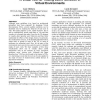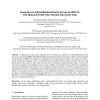1400 search results - page 226 / 280 » Design and evaluation of reduced-functionality interfaces |
CSCW
2008
ACM
15 years 1 months ago
2008
ACM
In this paper we describe a study that explored the implications of the Social Translucence framework for designing systems that support communications at work. Two systems design...
AVI
2004
15 years 1 months ago
2004
Although some guidelines (e.g., based on architectural principles) have been proposed for designing Virtual Environments (VEs), several usability problems can be identified only b...
101
click to vote
AROBOTS
2004
14 years 11 months ago
2004
In this paper, we report some important results of design and evaluation of a wheelchair-based robotic arm system, named as KARES II (KAIST Rehabilitation Engineering Service Syste...
CHI
2008
ACM
16 years 5 days ago
2008
ACM
In a typical speech dictation interface, the recognizer's bestguess is displayed as normal, unannotated text. This ignores potentially useful information about the recognizer...
105
click to vote
MHCI
2009
Springer
15 years 6 months ago
2009
Springer
Landmarks are a key element in navigation and have been used extensively to provide navigation support to pedestrians through mobile devices in urban areas. Natural environments d...


